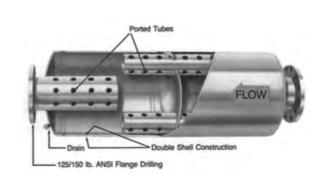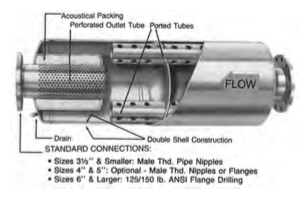In the first part of this series on Silencing Noisy Blowers, we discussed noise sources and frequencies. In the second part of this series, we will be discussing how blower silencers can be used to silence a noisy PD blower.
Silencers Types
The most common way to reduce PD blower noise is to use silencers. Knowing the operating speed of the PD blower and the noise frequencies generated are important in deciding which type to use. Simple chamber style silencers are most effective when a PD blower operating below its transition speed and generating primarily low frequency noise. Chamber style silencers are also referred to as reactive silencers. Chamber style silencers incorporate a series of expansion chambers and acoustically balanced bypass tubes for noise attenuation. Just like the muffler on a car, a chamber silencer lowers the noise level by creating destructive interference.
What if your PD blower is operating above its transitional speed and generating additional high frequency noise? The best solution would be an absorption-chamber style silencer. The fibers in the absorption material used in this type of silencer reduce high frequency noise by absorbing the energy. The short-wave length of high frequency noise will cause the fibers to vibrate and convert the sound energy to heat energy when the vibrating fibers rub against each other. 
There are some applications, such as wastewater treatment plants, where absorption material can’t be used for high frequency attenuation. Dürr Universal was the pioneer of the three chamber silencer that provides the same high frequency attenuation as an absorption-chamber style silencer.
Silencer Location
The air borne noise emitted from a PD blower comes from both the inlet and outlet. For small PD blowers, a combination filter/silencer on the inlet may be sufficient. Larger blowers need a separate filter and silencer to achieve optimal noise reduction. When a PD blower is being used in a vacuum application, the jet inlet will also require a silencer.
The majority of noise emitted from a PD blower is from the outlet. However, the silencer located on the outlet serves a dual purpose. In addition to reducing the air borne noise for people working around the PD blower, it also reduces the air pressure pulses that would otherwise be transmitted down the piping system. Without a silencer, these pulsations can vary from 40% to 80% of the absolute line pressure which can be highly destructive on downstream equipment.
Standard vs. Premium Silencers
The term premium or critical is sometimes confused with reference to the type of silencer. It actually refers to a silencer that has a larger chamber. So, it can be either a chamber or absorption-chamber style silencer. The benefit of the larger chamber is that it provides better low frequency attenuation because of the additional destructive interference.
Coming in Part 3 of this series, we will discuss using enclosures for quieting noisy PD Blowers.
